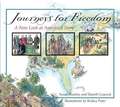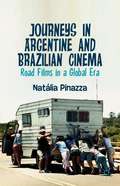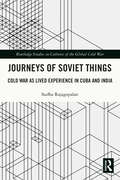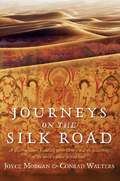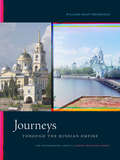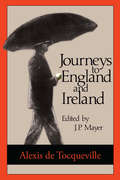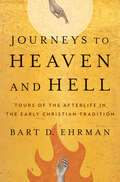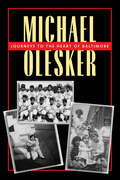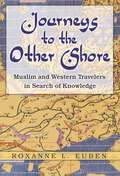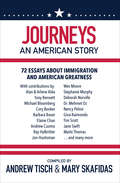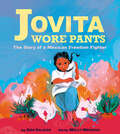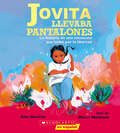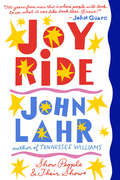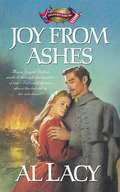- Table View
- List View
Journeys for Freedom: A New Look at America's Story
by Elspeth Leacock Susan Buckley Rodica PratoEach dynamic spread in Journeys for Freedom maps a factual account of real people pursuing freedom and creating America's story. Continuing their innovative storytelling approach, Susan Buckley and Elspeth Leacock invite you to trace the travelers across space and time as they forge a future for themselves and for our nation.
Journeys in Argentine and Brazilian Cinema: Road Films in a Global Era
by Natália PinazzaMany South American films that use the popular road movie format to examine regional culture and attitudes, especially in Argentina and Brazil. Pinazza performs a careful cultural analysis of the films and investigates how road movies deal with narratives on nationhood whilst simultaneously inserting themselves in a transnational dialogue.
Journeys in Ireland: Literary Travellers, Rural Landscapes, Cultural Relations
by Martin RyleThis volume offers a reasoned critical account of a wide range of travel writing about rural Ireland. The focus is on work by English travellers who visited Ireland for pleasure, from the ’scenic tourists’ of the post-Romantic period to Eric Newby in the 1980s. Ryle also discusses accounts by American and English anthropologists, as well as writing by Irish authors including J.M. Synge, George Moore, Sean O’Faolain and Colm TóibÃn. The materials reviewed and discussed here, including many books which are now difficult to find, offer illuminating and sometimes entertaining evidence about the development of tourism. Ryle also shows how the discourses and practices of pleasurable travel have intersected with and been marked by the dimensions of power and proprietorship, hegemony, and resistance, which have characterised Anglo-Irish and Hiberno-English cultural relations over the last two centuries. Journeys in Ireland will interest all those concerned with the literature and history of those relations, and will be an invaluable resource for scholars, teachers and students concerned with travel writing and tourism with and beyond these islands.
Journeys of Soviet Things: Cold War as Lived Experience in Cuba and India (Routledge Studies in Cultures of the Global Cold War)
by Sudha RajagopalanAt the intersection of history, material culture studies, and post-socialist memory studies, Journeys of Soviet Things is an oral history of socialist globalisation constructed around the journeys of Cold War era Soviet objects in India and Cuba. During the Cold War, an important means to perpetuate Soviet ideals of modernisation and anti-imperialist solidarity across the world was the circulation of ‘banal’ objects, produced in the Soviet Union and purchased, awarded, and gifted for use in homes across the world. Based on oral accounts of Indian and Cuban interlocutors, this book examines the itineraries of Soviet objects such as cars, washing machines, cameras, books, nesting dolls, porcelain, and many other things. Explored this way, the Cold War is a matter of personal, affective, everyday experience. At the same time, by indicating the cohabitation of things in their home from around the world, interlocutors also go on to undercut simple geopolitical binaries that pit Soviet against American techno-politics. Accounts of Soviet objects in India and Cuba reveal a bricolage of preferences that crisscrossed ideological dualities of East vs West, communist vs capitalist, making for an alternative cosmopolitanism that was in equal measure shaped by personal, local, and national histories and experiences. This book will appeal to researchers and students interested in Cold War history, the history of transnational solidarities, and Soviet material culture.
Journeys of the Mind: A Life in History
by Peter BrownA beautifully written personal account of the discovery of late antiquity by one of the world&’s most influential and distinguished historiansThe end of the ancient world was long regarded by historians as a time of decadence, decline, and fall. In his career-long engagement with this era, the widely acclaimed and pathbreaking historian Peter Brown has shown, however, that the &“neglected half-millennium&” now known as late antiquity was in fact crucial to the development of modern Europe and the Middle East. In Journeys of the Mind, Brown recounts his life and work, describing his efforts to recapture the spirit of an age. As he and other scholars opened up the history of the classical world in its last centuries to the wider world of Eurasia and northern Africa, they discovered previously overlooked areas of religious and cultural creativity as well as foundational institution-building. A respect for diversity and outreach to the non-European world, relatively recent concerns in other fields, have been a matter of course for decades among the leading scholars of late antiquity.Documenting both his own intellectual development and the emergence of a new and influential field of study, Brown describes his childhood and education in Ireland, his university and academic training in England, and his extensive travels, particularly in the eastern Mediterranean and the Middle East. He discusses fruitful interactions with the work of scholars and colleagues that include the British anthropologist Mary Douglas and the French theorist Michel Foucault, and offers fascinating snapshots of such far-flung places as colonial Sudan, midcentury Oxford, and prerevolutionary Iran. With Journeys of the Mind, Brown offers an essential account of the &“grand endeavor&” to reimagine a decisive historical moment.
Journeys on the Silk Road: A Desert Explorer, Buddha's Secret Library, and the Unearthing of the World's Oldest Printed Book
by Joyce Morgan Conrad WaltersWhen a Chinese monk broke into a hidden cave in 1900, he uncovered one of the world&’s great literary secrets: a time capsule from the ancient Silk Road. Inside, scrolls were piled from floor to ceiling, undisturbed for a thousand years. The gem within was the Diamond Sutra of AD 868. This key Buddhist teaching, made 500 years before Gutenberg inked his press, is the world&’s oldest printed book.The Silk Road once linked China with the Mediterranean. It conveyed merchants, pilgrims and ideas. But its cultures and oases were swallowed by shifting sands. Central to the Silk Road&’s rediscovery was a man named Aurel Stein, a Hungarian-born scholar and archaeologist employed by the British service.Undaunted by the vast Gobi Desert, Stein crossed thousands of desolate miles with his fox terrier Dash. Stein met the Chinese monk and secured the Diamond Sutra and much more. The scroll&’s journey—by camel through arid desert, by boat to London&’s curious scholars, by train to evade the bombs of World War II—merges an explorer&’s adventures, political intrigue, and continued controversy.The Diamond Sutra has inspired Jack Kerouac and the Dalai Lama. Its journey has coincided with the growing appeal of Buddhism in the West. As the Gutenberg Age cedes to the Google Age, the survival of the Silk Road&’s greatest treasure is testament to the endurance of the written word.
Journeys through the Russian Empire: The Photographic Legacy of Sergey Prokudin-Gorsky
by William Craft BrumfieldAt the turn of the twentieth century, the photographer Sergey Prokudin-Gorsky undertook a quest to document an empire that was undergoing rapid change due to industrialization and the building of railroads. Between 1903 and 1916 Prokudin-Gorsky, who developed a pioneering method of capturing color images on glass plates, scoured the Russian Empire with the patronage of Nicholas II. Intrepidly carrying his cumbersome and awkward camera from the western borderlands over the Volga River to Siberia and central Asia, he created a singular record of Imperial Russia.In 1918 Prokudin-Gorsky escaped an increasingly chaotic, violent Russia and regained nearly 2,000 of his bulky glass negatives. His subsequent peripatetic existence before settling in Paris makes his collection's survival all the more miraculous. The U.S. Library of Congress acquired Prokudin-Gorsky's collection in 1948, and since then it has become a touchstone for understanding pre-revolutionary Russia. Now digitized and publicly available, his images are a sensation in Russia, where people visit websites dedicated to them.William Craft Brumfield—photographer, scholar, and the leading authority on Russian architecture in the West—began working with Prokudin-Gorsky's photographs in 1985. He curated the first public exhibition of them in the United States and has annotated the entire collection. In Journeys through the Russian Empire, Brumfield—who has spent decades traversing Russia and photographing buildings and landscapes in their various stages of disintegration or restoration—juxtaposes Prokudin-Gorsky's images against those he took of the same buildings and areas. In examining the intersections between his own photography and that of Prokudin-Gorsky, Brumfield assesses the state of preservation of Russia's architectural heritage and calls into question the nostalgic assumptions of those who see Prokudin-Gorsky's images as the recovery of the lost past of an idyllic, pre-Soviet Russia.This lavishly illustrated volume—which features some 400 stunning full-color images of ancient churches and mosques, railways and monasteries, towns and remote natural landscapes—is a testament to two brilliant photographers whose work prompts and illuminates, monument by monument, questions of conservation, restoration, and cultural identity and memory.
Journeys to England and Ireland (European Political Thought Ser.)
by Alexis de TocquevilleThis extraordinary series of observations on England and Ireland complements de Tocqueville's masterpieces on the United States and France in the mid-nineteenth century. These pages are perhaps the most penetrating writings on the spirit of British politics. In effect, as indicated by John Stuart Mill, de Tocqueville was the Montesquieu of the nineteenth century. This is especially the case if one thinks of the present Irish situation. His political acumen reached into the future -which is now our present.
Journeys to Heaven and Hell: Tours of the Afterlife in the Early Christian Tradition
by Bart D. EhrmanA New York Times best-selling scholar's illuminating exploration of the earliest Christian narrated journeys to heaven and hell “[An] illuminating deep dive . . . An edifying origin story for contemporary Christian conceptions of the afterlife.”—Publishers Weekly From classics such as the Odyssey and the Aeneid to fifth-century Christian apocrypha, narratives that described guided tours of the afterlife played a major role in shaping ancient notions of morality and ethics. In this new account, acclaimed author Bart Ehrman contextualizes early Christian narratives of heaven and hell within the broader intellectual and cultural worlds from which they emerged. He examines how fundamental social experiences of the early Christian communities molded the conceptions of the afterlife that eventuated into the accepted doctrines of heaven, hell, and purgatory. Drawing on Greek and Roman epic poetry, early Jewish writings such as the Book of Watchers, and apocryphal Christian stories including the Acts of Thomas, the Gospel of Nicodemus, and the Apocalypse of Peter, Ehrman demonstrates that ancient tours of the afterlife promoted reflection on matters of ethics, faith, ambition, and life’s meaning, the fruit of which has been codified into Christian belief today.
Journeys to the Heart of Baltimore
by Michael OleskerIn Journeys to the Heart of Baltimore, veteran journalist Michael Olesker writes of Baltimore's melting pot in all its rollicking, sentimental, good-natured, and chaotic essence. The stories come from neighborhood street corners and front stoops, playgrounds and school rooms, churches and synagogues, and families gathered around late-night kitchen tables.The D'Alesandro political dynasty comes to life here, and so do Lenny Moore and Artie Donovan of the legendary Baltimore Colts. The old East Baltimore ethnic enclaves nurture youngsters named Barbara Mikulski and Ted Venetoulis, and out of West Baltimore comes the future Afro-American newspaper publisher Jake Oliver.Journeys to the Heart of Baltimore is a delightful reminder of the nation's ethnic and racial mosaic, home to a future governor named Martin O'Malley and a future U.S. Representative named Dutch Ruppersberger. Boys from Baltimore's Little Italy, like John Pica, go off to fight a war in Italy when they know their allegiance is being tested. And a city struggles through racial convulsions, remembered by those such as John Steadman and Father Constantine Sitaris.
Journeys to the Other Shore: Muslim and Western Travelers in Search of Knowledge (Princeton Studies in Muslim Politics #23)
by Roxanne L. EubenThe contemporary world is increasingly defined by dizzying flows of people and ideas. But while Western travel is associated with a pioneering spirit of discovery, the dominant image of Muslim mobility is the jihadi who travels not to learn but to destroy. Journeys to the Other Shore challenges these stereotypes by charting the common ways in which Muslim and Western travelers negotiate the dislocation of travel to unfamiliar and strange worlds. In Roxanne Euben's groundbreaking excursion across cultures, geography, history, genre, and genders, travel signifies not only a physical movement across lands and cultures, but also an imaginative journey in which wonder about those who live differently makes it possible to see the world differently. In the book we meet not only Herodotus but also Ibn Battuta, the fourteenth-century Moroccan traveler. Tocqueville's journeys are set against a five-year sojourn in nineteenth-century Paris by the Egyptian writer and translator Rifa'a Rafi' al-Tahtawi, and Montesquieu's novel Persian Letters meets with the memoir of an East African princess, Sayyida Salme. This extraordinary book shows that curiosity about the unknown, the quest to understand foreign cultures, critical distance from one's own world, and the desire to remake the foreign into the familiar are not the monopoly of any single civilization or epoch. Euben demonstrates that the fluidity of identities, cultures, and borders associated with our postcolonial, globalized world has a long history--one shaped not only by Western power but also by an Islamic ethos of travel in search of knowledge.
Journeys: 72 Essays about Immigration and American Greatness
by Alan Alda Arlene AldaA compilation of American immigration tales, featuring seventy-two essays from Nancy Pelosi, Dr. Oz, Michael Bloomberg, Alan Alda, Mary Choi, and others. Journeys captures the quintessential idea of the American dream. The individuals in this book are only a part of the brilliant mosaic of people who came to this country and made it what it is today. Read about the governor&’s grandfathers who dug ditches and cleaned sewers, laying the groundwork for a budding nation; how a future cabinet secretary crossed the ocean at age eleven on a cargo ship; about a young boy who fled violence in Budapest to become one of the most celebrated American football players; the girl who escaped persecution to become the first Vietnamese American woman ever elected to the US congress; or the limo driver whose family took a seventy-year detour before finally arriving at their original destination, along with many other fascinating tales of extraordinary and everyday Americans. In association with the New-York Historical Society, Andrew Tisch and Mary Skafidas have reached out to a variety of notable figures to contribute an enlightening and unique account of their family&’s immigration story. All profits will be donated to the New-York Historical Society and the Statue of Liberty Ellis Island Foundation. Featuring essays by: Arlene Alda, Tony Bennett, Cory Booker, Barbara Boxer, Elaine Chao, Andrew Cuomo, Ray Halbritter, Jon Huntsman, Wes Moore, Stephanie Murphy, Deborah Norville, Dr. Mehmet Oz, Gina Raimondo, Tim Scott, Jane Swift, Marlo Thomas, And many more! &“Illustrate[s] the positive and powerful impact that immigration has had in weaving the fabric of America . . . inspiring.&” —Warren Buffett
Jovita Wore Pants: The Story of a Mexican Freedom Fighter
by Aida SalazarJovita dreamed of wearing pants! She hated the big skirts Abuela made her wear. She wanted to scale the tallest mesquite tree on her rancho, ride her horse, and feel the wind curl her face into a smile <P><P> When her father and brothers joined the Cristero War to fight for religious freedom, Jovita wanted to go, too. Forbidden, she defied her father's rules - and society's - and found a clever way to become a trailblazing revolutionary, wearing pants! <P><P> This remarkable true story about a little-known maverick Mexican heroine is brought vividly to life by her great-niece and Américas Award-winner Aida Salazar, and Eisner Award-honoree Molly Mendoza. <P><P><i>Advisory: Bookshare has learned that this book offers only partial accessibility. We have kept it in the collection because it is useful for some of our members. Benetech is actively working on projects to improve accessibility issues such as these.</i>
Jovita llevaba pantalones: La historia de una mexicana que luchó por la libertad (Jovita Wore Pants)
by Aida SalazarThe remarkable true story of Jovita Valdovinos, a Mexican revolutionary who disguised herself as a man to fight for her rights, told by her great-niece, award-winning author, Aida Salazar!Jovita soñaba con poder usar pantalones como sus hermanos Ramón y Luciano.Cuando su padre y sus hermanos marcharon a la Guerra Cristera a luchar por el derecho a practicar libremente su religión, ella quiso ayudar. Entonces sobrevino la tragedia, y Jovita se vio obligada a cortarse el pelo, ponerse pantalones y continuar la lucha. Disfrazada de hombre, se puso al mando de un batallón que la siguió sin dudar.Jovita dreamed of wearing pants like her brothers, Ramón and Luciano.When her father and brothers joined the Cristeros War to fight for the right to practice religion freely, she wanted to help. Then tragedy struck, compelling Jovita to cut her hair, put on pants, and continue the fight. Disguised as a man, she commanded a battalion who followed her without question.
Joy Division: The Secret History (The\secret History Of Rock Ser.)
by Alan CrossAlan Cross is the preeminent chronicler of popular music.Here he provides a history of Ian Curtis and Joy Division.The text of this look at the band—"Here Come the Young Men"—is adapted from the audiobook of the same name.
Joy Goddess: A'Lelia Walker and the Harlem Renaissance
by A'Lelia BundlesA vibrant, deeply researched biography of A&’Lelia Walker—daughter of Madam C.J. Walker and herself a central figure of the Harlem Renaissance—written by her great-granddaughter.Dubbed the &“joy goddess of Harlem&’s 1920s&” by poet Langston Hughes, A&’Lelia Walker, daughter of millionaire entrepreneur Madam C.J. Walker and the author&’s great-grandmother and namesake, is a fascinating figure whose legendary parties and Dark Tower salon helped define the Harlem Renaissance. After inheriting her mother&’s hair care enterprise, A&’Lelia would become America&’s first high profile black heiress and a prominent patron of the arts. Joy Goddess takes readers inside her three New York homes—a mansion, a townhouse, and a pied-a-terre—where she entertained Langston Hughes, Zora Neale Hurston, Paul Robeson, Florence Mills, James Weldon Johnson, Carl Van Vechten, W.E.B. DuBois, and other cultural, social and intellectual luminaries of the Roaring Twenties. Now, based on extensive research and Walker&’s personal correspondence, her great-granddaughter creates a meticulous, nuanced portrait of a charismatic woman struggling to define herself as a wife, mother, and businesswoman outside her famous mother&’s sphere. In Joy Goddess, A&’Lelia&’s radiant personality and impresario instincts—at the center of a vast, artistic social world where she flourished as a fashion trendsetter and international traveler—are brought to vivid and unforgettable life.
Joy Ride
by John LahrJoy Ride throws open the stage door and introduces readers to such makers of contemporary drama as Arthur Miller, Tony Kushner, Wallace Shawn, Harold Pinter, David Rabe, David Mamet, Mike Nichols, and August Wilson. Lahr takes us to the cabin in the woods that Arthur Miller built in order to write Death of a Salesman; we walk with August Wilson through the Pittsburgh ghetto where we encounter the inspiration for his great cycle; we sit with Ingmar Bergman at the Kunglinga Theatre in Stockholm, where he attended his first play; we visit with Harold Pinter at his London home and learn the source of the feisty David Mamet's legendary ear for dialogue. In its juxtaposition of biographical detail and critical analysis, Joy Ride explores with insight and panache not only the lives of the theatricals but the liveliness of the stage worlds they have created.
Joy from Ashes (Battles of Destiny Series #5)
by Al LacyFighting for the Confederacy, Major Dalton learns that enemy soldiers have hurt his beloved wife and caused the death of their unborn son. Will he obtain revenge, or learn that vengeance truly belongs to the Lord?From the Trade Paperback edition.
Joy of the Worm: Suicide and Pleasure in Early Modern English Literature (Thinking Literature)
by Drew DanielConsulting an extensive archive of early modern literature, Joy of the Worm asserts that voluntary death in literature is not always a matter of tragedy. In this study, Drew Daniel identifies a surprisingly common aesthetic attitude that he calls “joy of the worm,” after Cleopatra’s embrace of the deadly asp in Shakespeare’s play—a pattern where voluntary death is imagined as an occasion for humor, mirth, ecstatic pleasure, even joy and celebration. Daniel draws both a historical and a conceptual distinction between “self-killing” and “suicide.” Standard intellectual histories of suicide in the early modern period have understandably emphasized attitudes of abhorrence, scorn, and severity toward voluntary death. Daniel reads an archive of literary scenes and passages, dating from 1534 to 1713, that complicate this picture. In their own distinct responses to the surrounding attitude of censure, writers including Shakespeare, Donne, Milton, and Addison imagine death not as sin or sickness, but instead as a heroic gift, sexual release, elemental return, amorous fusion, or political self-rescue. “Joy of the worm” emerges here as an aesthetic mode that shades into schadenfreude, sadistic cruelty, and deliberate “trolling,” but can also underwrite powerful feelings of belonging, devotion, and love.
Joy of the Worm: Suicide and Pleasure in Early Modern English Literature (Thinking Literature)
by Drew DanielConsulting an extensive archive of early modern literature, Joy of the Worm asserts that voluntary death in literature is not always a matter of tragedy. In this study, Drew Daniel identifies a surprisingly common aesthetic attitude that he calls “joy of the worm,” after Cleopatra’s embrace of the deadly asp in Shakespeare’s play—a pattern where voluntary death is imagined as an occasion for humor, mirth, ecstatic pleasure, even joy and celebration. Daniel draws both a historical and a conceptual distinction between “self-killing” and “suicide.” Standard intellectual histories of suicide in the early modern period have understandably emphasized attitudes of abhorrence, scorn, and severity toward voluntary death. Daniel reads an archive of literary scenes and passages, dating from 1534 to 1713, that complicate this picture. In their own distinct responses to the surrounding attitude of censure, writers including Shakespeare, Donne, Milton, and Addison imagine death not as sin or sickness, but instead as a heroic gift, sexual release, elemental return, amorous fusion, or political self-rescue. “Joy of the worm” emerges here as an aesthetic mode that shades into schadenfreude, sadistic cruelty, and deliberate “trolling,” but can also underwrite powerful feelings of belonging, devotion, and love.
Joy of the Worm: Suicide and Pleasure in Early Modern English Literature (Thinking Literature)
by Drew DanielConsulting an extensive archive of early modern literature, Joy of the Worm asserts that voluntary death in literature is not always a matter of tragedy. In this study, Drew Daniel identifies a surprisingly common aesthetic attitude that he calls “joy of the worm,” after Cleopatra’s embrace of the deadly asp in Shakespeare’s play—a pattern where voluntary death is imagined as an occasion for humor, mirth, ecstatic pleasure, even joy and celebration. Daniel draws both a historical and a conceptual distinction between “self-killing” and “suicide.” Standard intellectual histories of suicide in the early modern period have understandably emphasized attitudes of abhorrence, scorn, and severity toward voluntary death. Daniel reads an archive of literary scenes and passages, dating from 1534 to 1713, that complicate this picture. In their own distinct responses to the surrounding attitude of censure, writers including Shakespeare, Donne, Milton, and Addison imagine death not as sin or sickness, but instead as a heroic gift, sexual release, elemental return, amorous fusion, or political self-rescue. “Joy of the worm” emerges here as an aesthetic mode that shades into schadenfreude, sadistic cruelty, and deliberate “trolling,” but can also underwrite powerful feelings of belonging, devotion, and love.
Joy to the World: A Regency Christmas Collection
by Erica Vetsch Carolyn Miller Amanda BarrattInspirational Regency romance with a Christmas twist from three best-selling authorsIn Joy to the World, three popular authors come together to offer a heartwarming collection of holiday Regency romance. Based on lines from a beloved Christmas carol, these three novellas in one book have depth, faith, and satisfying stories all packed into the perfect length for readers to curl up and take a brief break from their holiday busyness."Heaven and Nature Sing" by Carolyn MillerTwo music lovers, deeply devoted to each other, were on the brink of engagement when family circumstances drove them apart. How can they ever overcome their obligations and fears to find their way back into each other's arms?"Far as the Curse is Found" by Amanda BarrattOne winter night, a woman struggling to provide for her illegitimate child encounters a scarred veteran of the Napoleonic Wars on the streets of London. Can love conquer the darkness of two broken pasts?"Wonders of His Love" by Erica VetschA Scots portrait painter with a hidden identity finds work at a noble manor house over the holidays. He never imagined he'd fall in love with the emotionally frozen widow there. Now he wants nothing more than to thaw her heart.
Joy!: Photographs of Life's Happiest Moments
by Bruce VelickJoy! This universal human emotion soothes the soul and lifts the spirit, even in troubled times. From a child's laughter to a grandmother's smile, each photograph in this handy hardcover book captures a moment of pure, unadulterated happiness. Precious instants, perfect for sharing with a new parent, a graduate, a loved one, or a friend in need of a pick-me-up, are gathered here. Because, after all, smiles are contagious!
Joyas de la familia
by Sergio E. Avilés«Mi cerebro no guarda secretos, ni recuerdos ya. Es una cárcel con techo de paja en la que los recuerdos reposan la parranda y después se van.» Rubén Pablo Alcocer tiene 54 años, es detective privado y vive en Saltillo. Pudo haber sido filósofo y, quizá, más le habría valido, pues su más reciente trabajo lo ha llevado a una situación por demás complicada: un hombre y una mujer lo tienen amarrado a una silla, le han colocado una bolsa de plástico sobre la cabeza y le han clavado palillos debajo de las uñas. Sus captores quieren saber dónde ha quedado la antigua gargantilla de diamantes de su clienta, otrora propiedad de la corona de Rumania. Para resistir el tormento, hace un recuento de la larga historia de la alhaja, que se remonta hasta el siglo XV, atravesando los destinos de diversas dinastías europeas, y en la que participan tanto Napoleón como la reina Victoria y el mismo conde Drácula. Cruzar este memorioso laberinto quizá sea la clave para escapar de la muerte. Este relato, fascinante combinación de thriller y novela histórica, nos recuerda que toda familia tiene sus joyas, piedras y personas de distintas durezas, que componen un mosaico de amor y desamor, traición y deseo. También de memoria y olvido. A veces, deseo de olvidar.
Joyce Wieland's 'The Far Shore'
by Johanne SloanThe Far Shore (1976), made under the direction of celebrated visual artist and experimental filmmaker Joyce Wieland, is one of Canada's most innovative contributions to cinema. The film borrows elements from the life of Canadian painter Tom Thomson, who is represented by the character of Tom McLeod. The main character, however, is not Tom, but the fictional creation of Eulalie de Chicoutimi, the married Québécoise woman who loves him. Using Eulalie's perspective, Wieland was able to re-frame Thomson's life and story as a romantic melodrama while infusing it with subversive commentary on gender, nature and nationalism, and ultimately, on the value of art.Here, Wieland specialist Johanne Sloan offers a fascinating new perspective on The Far Shore, making it more accessible by discussing Wieland's utopian fusion of art and politics, the importance of landscape within Canadian culture, and the on-going struggle over the meaning of the natural environment.
